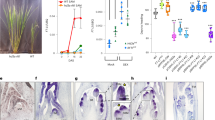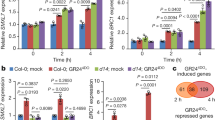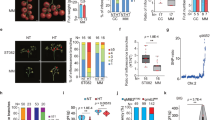Abstract
Inflorescence branching is a major yield trait in crop plants controlled by the developmental fate of axillary shoot meristems1. Variations in branching patterns lead to diversity in flower-bearing architectures (inflorescences) and affect crop yield by influencing seed number or harvesting ability2,3. Several growth regulators such as auxins, cytokinins and carotenoid derivatives regulate branching architectures4. Inflorescence branching in maize is regulated by three RAMOSA genes5. Here we show that one of these genes, RAMOSA3 (RA3), encodes a trehalose-6-phosphate phosphatase expressed in discrete domains subtending axillary inflorescence meristems. Genetic and molecular data indicate that RA3 functions through the predicted transcriptional regulator RAMOSA1 (RA1)5. We propose that RA3 regulates inflorescence branching by modification of a sugar signal that moves into axillary meristems. Alternatively, the fact that RA3 acts upstream of RA1 supports a hypothesis that RA3 itself may have a transcriptional regulatory function.
This is a preview of subscription content, access via your institution
Access options
Subscribe to this journal
Receive 51 print issues and online access
$199.00 per year
only $3.90 per issue
Buy this article
- Purchase on Springer Link
- Instant access to full article PDF
Prices may be subject to local taxes which are calculated during checkout



Similar content being viewed by others
References
Ward, S. P. & Leyser, O. Shoot branching. Curr. Opin. Plant Biol. 7, 73–78 (2004)
Doebley, J. Mapping the genes that made maize. Trends Genet. 8, 302–307 (1992)
Bommert, P., Satoh-Nagasawa, N., Jackson, D. & Hirano, H. Genetics and evolution of inflorescence and flower development in grasses. Plant Cell Physiol. 46, 69–78 (2005)
Schmitz, G. & Theres, K. Shoot and inflorescence branching. Curr. Opin. Plant Biol. 8, 506–511 (2005)
Vollbrecht, E., Springer, P. S., Goh, L., Buckler, E. S. & Martienssen, R. Architecture of floral branch systems in maize and related grasses. Nature 436, 1119–1126 (2005)
Strom, A. R. & Kaasen, I. Trehalose metabolism in Escherichia coli: stress protection and stress regulation of gene expression. Mol. Microbiol. 8, 205–210 (1993)
Thevelein, J. M. & Hohmann, S. Trehalose synthase: guard to the gate of glycolysis in yeast? Trends Biochem. Sci. 20, 3–10 (1995)
Goddijn, O. J. & van Dun, K. Trehalose metabolism in plants. Trends Plant Sci. 4, 315–319 (1999)
Leyman, B., Van Dijck, P. & Thevelein, J. M. An unexpected plethora of trehalose biosynthesis genes in Arabidopsis thaliana. Trends Plant Sci. 6, 510–513 (2001)
Eastmond, P. J., Li, Y. & Graham, I. A. Is trehalose-6-phosphate a regulator of sugar metabolism in plants? J. Exp. Bot. 54, 533–537 (2003)
Schluepmann, H., Pellny, T., van Dijken, A., Smeekens, S. & Paul, M. Trehalose 6-phosphate is indispensable for carbohydrate utilization and growth in Arabidopsis thaliana. Proc. Natl Acad. Sci. USA 100, 6849–6854 (2003)
Cabib, E. & Leloir, L. F. The biosynthesis of trehalose phosphate. J. Biol. Chem. 231, 259–275 (1958)
Schluepmann, H. et al. Trehalose mediated growth inhibition of Arabidopsis seedlings is due to trehalose-6-phosphate accumulation. Plant Physiol. 135, 879–890 (2004)
van Dijken, A. J., Schluepmann, H. & Smeekens, S. C. Arabidopsis trehalose-6-phosphate synthase 1 is essential for normal vegetative growth and transition to flowering. Plant Physiol. 135, 969–977 (2004)
Perry, H. S. Maize Genetics/Genomics Database [online] http://www.maizegdb.org/.
Michelmore, R. W., Paran, I. & Kesseli, R. V. Identification of markers linked to disease-resistance genes by bulked segregant analysis: A rapid method to detect markers in specific genomic regions by using segregating populations. Proc. Natl Acad. Sci. USA 88, 9828–9832 (1991)
Thaller, M. C., Schippa, S. & Rossolini, G. M. Conserved sequence motifs among bacterial, eukaryotic, and archaeal phosphatases that define a new phosphohydrolase superfamily. Protein Sci. 7, 1647–1652 (1998)
Plant Genome DataBase. [online] http://www.plantgdb.org/prj/GSSAssembly/.
The Institute for Genomic Research. The TIGR Maize Database [online] http://www.tigr.org/tdb/tgi/maize/.
Emrich, S. J. et al. A strategy for assembling the maize (Zea mays L.) genome. Bioinformatics 20, 140–147 (2004)
Huelsenbeck, J. P. & Ronquist, F. MrBayes: Bayesian inference of phylogenetic trees. Bioinformatics 17, 754–755 (2001)
Vogel, G., Aeschbacher, R. A., Muller, J., Boller, T. & Wiemken, A. Trehalose-6-phosphate phosphatases from Arabidopsis thaliana: identification by functional complementation of the yeast tps2 mutant. Plant J. 13, 673–683 (1998)
Klutts, S. et al. Purification, cloning, expression, and properties of mycobacterial trehalose-phosphate phosphatase. J. Biol. Chem. 278, 2093–2100 (2003)
De Virgilio, C. et al. Disruption of TPS2, the gene encoding the 100-kDa subunit of the trehalose-6-phosphate synthase/phosphatase complex in Saccharomyces cerevisiae, causes accumulation of trehalose-6-phosphate and loss of trehalose-6-phosphate phosphatase activity. Eur. J. Biochem. 212, 315–323 (1993)
Pellny, T. K. et al. Genetic modification of photosynthesis with E. coli genes for trehalose synthesis. Plant Biotechnol. J. 2, 71–82 (2004)
Kolbe, A. et al. Trehalose-6-phosphate regulates starch synthesis via posttranscriptional redox activation of ADP-glucose pyrophosphorylase. Proc. Natl Acad. Sci. USA 102, 11118–11123 (2005)
Kim, J.-w. & Dang, C. V. Multifaceted roles of glycolytic enzymes. Trends Biochem. Sci. 30, 142–150 (2005)
Taguchi-Shiobara, F., Yuan, Z., Hake, S. & Jackson, D. The fasciated ear2 gene encodes a leucine rich repeat receptor like protein that regulates shoot meristem proliferation in maize. Genes Dev. 15, 2755–2766 (2001)
Acknowledgements
We thank C. Carson and E. Coe for initial molecular mapping of RA3; S. Hake for the fea1-Mu line; N. Inada, E. Irish, J. Linder and E. Vollbrecht for ra3 alleles; T. Mulligan for plant care; J. Andersen, N. Kobayashi-Simorowski and N. Tonks for help with phosphatase assays; V. Koroth Edavana for suggestions about the Mycobacterium TPP clone; P. Dahl, D. Goto, K. Noma and T. Phelps-Durr for suggestions for the yeast complementation test; J. Kossuth for help with DNA sequencing; and E. Kellogg, W. Lukowitz, J. Simorowski, E. Vollbrecht, and members of the Jackson laboratory for comments on the manuscript. Funding was provided by the National Science Foundation, Plant Genome Research Program, and the National Research Initiative of the USDA Cooperative State Research, Education and Extension Service (to D.J.). Author Contributions N.S.-N. performed the SEM analyses, RA3 mapping, RT–PCRs, in situ hybridizations, double-mutant analyses, phosphatase assay and yeast complementation test. N.N. helped with RA3 mapping and provided the material for RT–PCR in rice. S.M. performed phylogenetic analyses and in situ hybridizations in rice. H.S. organized the collaboration. D.J. supervised the research and wrote the paper. All authors discussed the results and commented on the manuscript.
Author information
Authors and Affiliations
Corresponding author
Ethics declarations
Competing interests
Accession numbers for gene sequences are listed in Supplementary Fig. 2. Reprints and permissions information is available at npg.nature.com/reprintsandpermissions. The authors declare no competing financial interests.
Supplementary information
Supplementary Notes
This file contains Supplementary Figures 1–4, Supplementary Tables 1 and 2, Supplementary Methods and additional references. (DOC 336 kb)
Rights and permissions
About this article
Cite this article
Satoh-Nagasawa, N., Nagasawa, N., Malcomber, S. et al. A trehalose metabolic enzyme controls inflorescence architecture in maize. Nature 441, 227–230 (2006). https://doi.org/10.1038/nature04725
Received:
Accepted:
Issue Date:
DOI: https://doi.org/10.1038/nature04725
This article is cited by
-
Characterization of sub-tropical maize (Zea Mays L.) inbred lines for the variation in kernel row numbers (KRNs)
Cereal Research Communications (2024)
-
Genome- and transcriptome-wide identification of trehalose-6-phosphate phosphatases (TPP) gene family and their expression patterns under abiotic stress and exogenous trehalose in soybean
BMC Plant Biology (2023)
-
OsDPE2 Regulates Rice Panicle Morphogenesis by Modulating the Content of Starch
Rice (2023)
-
QTG-Miner aids rapid dissection of the genetic base of tassel branch number in maize
Nature Communications (2023)
-
Singlet oxygen-induced signalling depends on the metabolic status of the Chlamydomonas reinhardtii cell
Communications Biology (2023)
Comments
By submitting a comment you agree to abide by our Terms and Community Guidelines. If you find something abusive or that does not comply with our terms or guidelines please flag it as inappropriate.



